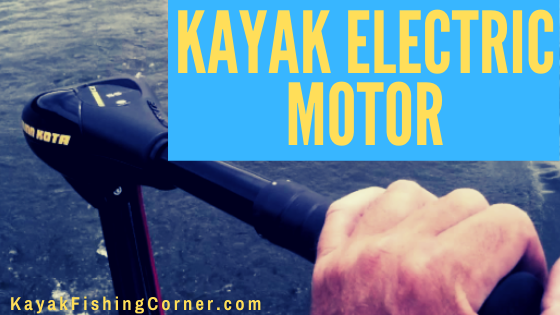Jump Ahead To:
KAYAK ELECTRIC MOTOR: INTRO
Paddling a kayak by hand can be tiring, and using a pedal kayak when kayak fishing can wear you out too quickly. Did you know that there is an alternative? Well, there is – A kayak with an electric motor! People tend to refer to these type of kayak motors as “trolling motors”. Not familiar with trolling motors? Before you get into this article, we would suggest that you take a look at KFC’s Kayak Trolling Motor Ultimate Guide – where we have written a thorough article containing everything you need to know about kayak trolling motors.
We have even ranked The 5 Best Kayak Trolling Motors! After that, you’re ready to see if a kayak with an electric motor might be right for you! Let’s go!
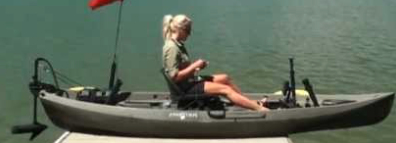
Kayak Electric Motor: Guide
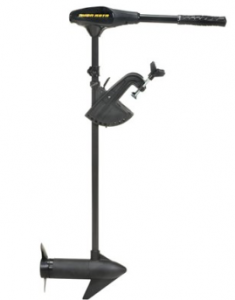
First, as an Amazon Associate, I earn from qualifying purchases.
Welcome to KFC’s review of kayaks with electric motors! This article contains all of the important information about kayak motors relative to their use in kayak fishing! Above, we have included a picture of a “basic” trolling motor so that you could familiarize yourself with the subject of this post. We start this article by providing some basic information about kayaks with electric motors – What are they? Are they safe? Do they work in the ocean? Can I buy a motor on the aftermarket? Do I have to buy a pre-assembled electric kayak?
After you get up to speed on some of the basics, you’ll want to read our section on how to use a kayak with an electric motor. After all, owning such a kayak and not knowing how to use (or install) it isn’t going to do you much good! After that, we have added a short section that details some of the most important features that you’ll want to find in whatever electric kayak you decide to buy!
Once you’ve read through some of the most important features, you might be interested in seeing if KFC has identified any kayaks with electric motors that we’d feel comfortable suggesting that our readers evaluate. Well, we have! We have included a link to the product page of our favorite electric kayak so that you can visit the site to learn more! Finally, we have added a short narrative that details some of our own experiences using kayaks with electric motors. Hopefully learning of our own triumphs (and disasters) will help you become a better kayak fisherman! Ready to get started?
Kayak Electric Motor: The Basics
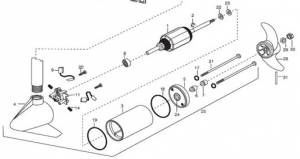
Please note: This post contains affiliate links. An affiliate link means that we may earn advertising/referral fees if you make a purchase through our links.
Shortcut to the Kayak Electric Motor Review
For those of you interested in the mechanics of it, the image above shows you the schematics of a kayak trolling motor. For the rest of us, let’s just start with a basic definition! A kayak trolling motor is a compact, lightweight and portable motor that is intended to be mounted to the front (bow mount) or side (transom mount) of a fishing kayak. The trolling motor’s purpose is to provide power and direction to aid a kayak fisherman as he or she navigates about the water!
Larger trolling motors are oftentimes installed on bass boats. Kayaks with electric motors, however, are becoming more and more popular on these waterways. Usually the kayak fisherman will opt for a trolling motor weighing between 25 and 35 pounds and able to produce 25 to 55 pounds of thrust. Remember, thrust is a type of measurement of mechanical force. The more thrust, the more powerful the electric motor.
It is equally common for kayak fisherman to buy standalone kayak motors as it is for them to buy a fully integrated, pre-assembled electric kayak. This article, however, will focus on kayaks with electric motors that have been added after the initial purpose (read: kayak trolling motors). While these are on the expensive side relative to other pieces of kayak fishing gear and accessories, they are typically very long lasting and have an immediate positive impact upon your abilities as a kayak fisherman. Ready to learn more?
How to Use Properly

Have you ever ridden a motorbike or motorcycle? Well, I haven’t, but I do know that these machines have similar throttles to that which you’ll find on most kayaks with electric motors. Learning the specifics of how to use an electric kayak is very important, not only to your safety, but to the safety of those on the water with you!
Below you will see a short numbered checklist that will walk you through some important steps and considerations when using an electric kayak. We always like to have a process when preparing to go kayak fishing (what clothes to wear, what equipment to bring, where is the boat launch, etc). It helps us avoid missing important details and results in a more enjoyable time. We hope that the list below can serve as your own guide to the process of using an electric kayak!

- It may sound boring, but any time you are working with power equipment, like a trolling motor, you’ll want to begin by referencing the user guide.
- After you’ve acquainted yourself with the user guide, you’ll want to remove the trolling motor from its box.
- Most trolling motors come with the main components fully assembled, such that all you need to do is attach the head (the top piece) to the handle, then move to the next step.
- Next, take the handle and head and place them atop the shaft. Make sure your connection is sound.
- After that, you’ll want to add the mounting bracket to the mid point of the shaft. The mounting bracket is the piece that will connect to the kayak motor mount.
- Now its time to attach the propeller to the metal casing, and the now connected motor with propeller to the bottom of the shaft.
- Your kayak motor mount should already be installed at this point, and now is the time to attach the mounting bracket to the motor mount.
- Be sure to adjust the height of the trolling motor so that it doesn’t sit too low into the water (when you know you’ll be in shallow areas) or too close to the surface.
- A kayak with an electric motor will perform best when the motor head is between 2.5 and 3.5 feet below the surface of the water – if its too shallow, you won’t get good propulsion or direction!
- Before heading onto the water, make sure you are familiarized with forward, reverse, and side to side maneuvering. Remember that to go left, you’ll need to push the throttle (or ruddering system, depending on your kayak) to the right! Have fun out there!
Kayak Electric Motor: Important Features
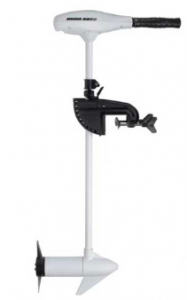
Luckily for us, the kayak fishing enthusiasts, there are an increasing number of kayaks with electric motors available on the marketplace today. Yes, there is definitely going to be some variability in quality, just as there is in price, but there are several high quality manufacturers that simply won’t lead you wrong.
Regardless of manufacturer, you’ll want to make sure that your kayak trolling motor has at least the three features that we’ve highlighted below. Yes, several models are available with two of the three features, or even “more” but different features, but if your kayak trolling motor doesn’t have the three most importance features that you’re about to learn about, we would suggest that you consider other options!

Powerful Motor. It may seem obvious, but you’ll want to buy a kayak with an electric motor that is appropriately sized for kayak fishing. As mentioned above, these types of motors typically come in sizes from 25 pounds of thrust to 55 pounds of thrust. Of course, there are other electric motors on the market that will provide far greater outputs of power, but these are typically reserved for much larger watercraft (like bass boats). It is our experience that kayak fisherman will need a motor capable of at least 40, but not more than 55, pounds of thrust. These power levels are more than enough to allow you to combat high winds, swift moving currents, and other hazards or elements that you may encounter when kayak fishing. If your kayak motor is too small, you may be at the mercy of the current (whether water or wind)! Take a look at a close up of the kayak’s electric motor (image shown below):
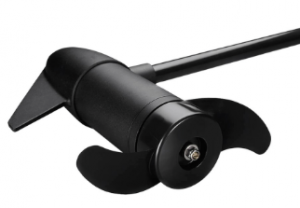
Proper Mounting Bracket. Do not. I repeat – DO NOT, buy a kayak with an electric motor that does not have a mounting bracket attached to its shaft. While we were doing the research necessary to prepare for the writing of this article, we were amazed just how many models totally omitted the mounting bracket from their design. Even some of the kayak motors that did have a mounting bracket used a design that we know from first hand experience to be susceptible to failure. Not sure what we mean by a kayak motor’s mounting bracket? Take a look at an example of a good one, below:
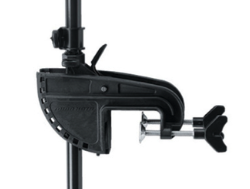
Do you see how this model has two “screw down” pieces with ergonomic handles and lay flat compression points? This is what you want your mounting bracket to look like. After all, it is this very connection where the kayak trolling motor affixes to the hull of the kayak (or at least the kayak motor mount). If your model features a “snap on” connection point, you need to abandon ship and move onto a model with a better design!
Battery Meter or Display. Kayaks with electric motors are fantastic pieces of equipment, but there is one potential problem that will sneak up on you if you aren’t aware of it. You see, these motors are battery powered, meaning that their source of power is finite. Yes, you could “risk” it by setting a period of time and estimating how much battery you have remaining, but you never truly know how hard the motor is working, and thus you don’t know how quickly the battery is depleting.
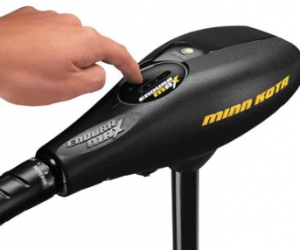
Make sure to buy a motor that comes with a digital display that is capable of measuring battery life. Trust us, while these models may be a little more expensive, they are well worth it! This is the only sure fire way to avoid being caught far from shore with a dead battery! The image included above shows what these displays typically look like. Notice that it is located at the head of the unit, right near the electric motor’s handle and within easy observation by the kayak fisherman!
Buy the Best Kayak Electric Motor
(Commissions Earned)
Perfect for your Fishing Kayak
The kayak motor depicted above is one of our favorites. It comes with all of the features that we mention above, and is offered by a high quality manufacturer who has been delivering superb watercraft products and materials for years. It has been wisely designed with a 6″ handle that is perfect for adjusting to any number of positions (or collapsing in on itself – a/k/a telescopic) to provide the kayak fisherman extra room. Kayaks are small, we’ll take all the extra room that we can get!
Recall our discussion of thrust above. This particular model can generate 55 pounds of thrust. Look, while anywhere upwards of 40 pounds is acceptable, why not add a little extra power if you can. If nothing else, it will help you beat your buddies to the best fishing hole! Also, the motor comes in variable shaft lengths (36″ and 42″). This variability is nice as it allows for the units to work on different sized fishing kayaks, and to be effective in predominantly shallower (or predominantly deeper) depths.
This model is in line with the normal weight for trolling motors (at least those suggested for kayaks with electric motors) at roughly 25 – 30 pounds. This lighter weight is nice because, unlike bow mount trolling motors, this model is a transom mount (mounts to the side of your kayak) and if it was too heavy, it may cause the kayak to lean too far to one side and cause for you to constantly drift while under power.
My Experience

I will admit that I was probably one of the last people on the planet who ever envisioned that he would be participating in kayak fishing with a kayak with an electric motor. I was always of the belief that there was one way, and only one way, to power a kayak and that was by kayak paddles! I don’t know what my hesitation was relative to giving an electric kayak a try but, after some pestering from a friend, I finally gave it a shot!
I immediately fell in love with the convenience that the electric motor provided me. Not only did it allow me to get from location to location more quickly, it allowed me to navigate up river or into tight channels without fear of becoming “stuck”. I could simply throw the kayak motor into reverse and back right on out. Also, my fears about mechanical “noise” from these motors was misguided. I had assumed that they were noise like their gas powered cousins and that this noise would take away from the serenity of kayak fishing. I was wrong. These motors are designed to be “run quiet” and, after just a few minutes, I forgot that they generated any noise whatsoever!
KAYAK ELECTRIC MOTOR: CONCLUSION

I hope this article has proven to be an informative source of information about kayaks with electric motors. These really are awesome pieces of kayak fishing gear. What other kayak fishing accessory provides you with the immediate ability to stay on the water longer, fish more locations, and come off of the water less fatigued at the end of the day?! By the way, if you are interested in learning more about trolling motors, take a look at this guide!
If you have made it to this point and find that you still have questions about kayaks with electric motors, have any tips or tricks, or want to share a story about your own experience, we would encourage you to post on the Comments board below. We read and respond to every comment and we love interacting with this free kayak fishing community! See you on the water!
If you are interested in competing in a kayak fishing tournament, take a look here for a list of great options!
Comments
Did you know that there were such things as kayaks with electric motors? Have you ever tried one out for yourself? What was your experience with it? Did you find that you were able to spend more time on the water? Did you experience any difficulties with mounting it to the hull of the kayak? Which model did you decide to go with and why? Make sure to share your story with this community! We want to hear from you!

